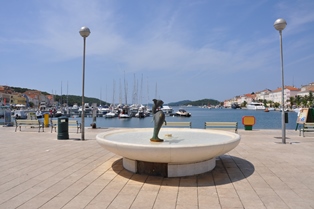Croatia has many romantic places, especially the popular Coast, which attract with its rich historical past, medieval appearance, secluded beaches, beautiful parks and plenty of opportunities for romantic walks along the sea, candlelight dinner and discovering many romantic places.
Pula
Like ancient Romes, the heritage of the city of romantic Pula reaches three thousand years in the past, it was also built on seven hills and all roads on the istrian peninsula lead to the town. Right in the centre of Pula we will find one of the best preserved Roman amphitheatres. The local people call it Arena. The Arena is probably the most impressive, but not the only ancient monument which is situated in Pula. In the centre of the town, the ancient Roman Forum, there is temple of Augustus, dedicated to the first Roman emperor Augustus. There is also the old citadel, the Sergius Arch, Gate of Hercules and many other historical landmarks.
Rovinj
Rovinj is one of the most romantic mediterranian towns. Located on the western coast of Istria, surrounded by wooded, gentle hills that protect it of the bora wind, Rovinj has been the perfect holiday destination for over a century. Besides its romantic views, for which it is known as the city of romance, the beauty of Rovinj is reflected in the nearby archipelago of 22 islands. Among them the most beautiful and the largest are St. Andrews and the St. Catherine islands. Near Rovinj there are many protected natural areas, such as Lim fjord, the swamp Palud, the Park Forest Punta Corrente and Romuald's cave.
Poreč
Once a small fishing village, Poreč represents one of the most brilliant jewels of Croatian tourism. Located of the west coast of Istria, where mild climate prevails, a rugged coastline with numerous islands, peninsulas and romantic beaches offer an amazing treasure of tourist attractions. Poreč is a romantic town that boasts a long and rich history. In Poreč is located one of the most beautiful early Byzantine churches in Europe, the Basilica of Euphranasius from the sixth century. The UNESCO put it on its list of world cultural heritage.
Opatija
Opatija boasts the longest tourist tradition in Croatia, the tradition was founded back in the time when the Habsburgs ruled the area. This may be due to its extremely favorable geographic position, just 500 kilometres from Vienna, Milan and Munich, and the fact that Opatija has been the most accessible way to the Mediterranean from Central Europe. Long romantic promenades and the most beautiful parks of Croatia embellish Opatija. The Villa Angiolina is the cradle of tourism in Opatija. In 1844, a local merchant from Rijeka bought the peninsula where the villa is located in order to built a home. He romantically named it after his wife.
Dubrovnik
Dubrovnik is located in the south of the country. It is undoubtedly the most important and the best known romantic destination in Croatia. Its specific medieval silhouette, the imposing town walls that for centuries protected the city against invaders from the land and from the sea will never be forgotten by anyone who at least once visited this fairy tale town. The entire old town is listed on UNECSO's World Heritage list, besides its unique architectural heritage, Dubrovnik is also seen as the Athens of Croatian culture.
























